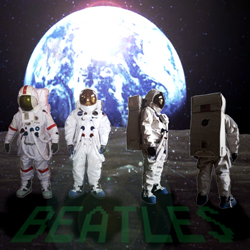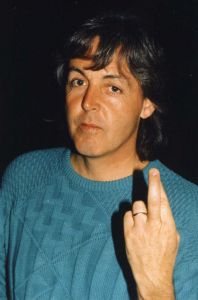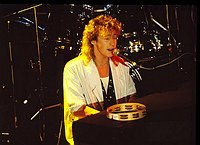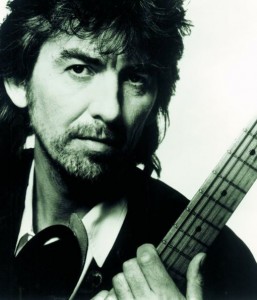 Part 9: Beatles In Space (1985)
Part 9: Beatles In Space (1985)
Before we begin, I’d like to give a special thanks to Dw. Dunphy for his amazing Photoshopped album covers. We saw one last time for Tug of Peace, and the cover here on the left is his brainchild as well. In addition, he did a really cool one for “Chaos,” but I’m going to save posting that for later, because…
I am officially soliciting contributions for the great “Fixing a Hole album cover contest!” Send your creations for any of the pseudo-Beatles albums to mfeldman1972@gmail.com. The only requirement is that if they have pictures of the Beatles on them, they have to be more or less contemporary with when the album was released. Here is a list (which of course is a partial spoiler for what’s to come, but there’s no way around that).
1970: Join the Human Race
1971: Imagine
1973: Mind Games
1974: Band On the Run
1975: Chaos
1977: The Beatles Grow Up
1980: Rockestra
1983: Tug Of Peace
1985: Beatles in Space
1989: Fab
1993: Help Yourself
1997: Flaming Pie
2000: Private Salt’s Accompanied Spades All-Inclusive Solo
2007: Memory Almost Full
And now, back to our regularly scheduled program.
OK, we’ve now crossed over into the realm of less-serious. It’s the 80s, the post-hippie sheen is off, a new generation of rock and rollers is growing up with MTV, compact discs, big hair, and a second British Invasion that’s really not much like the first. How do the Beatles (or rather, 75% of the Beatles and one descendant of a Beatle) survive?
Like Chaos from 1975, this album was not in my original plans. I thought that since George and Ringo were AWOL in the mid-80s, and Paul and Julian’s 1986 output was not really their strongest, to put it mildly, I’d just collect one or two tracks from this era and squeeze them in on the early 80s or late 80s albums. But then I developed this backlog’ of George material on the prior albums, recalled that Give My Regards To Broad Street does actually have a couple good tunes on it (i.e. the ones that weren’t just recycled McCartney or Beatle material), and realized that Julian’s Valotte has enough good songs to partially overflow onto another album. And finding one Ringo tune somewhere can’t be that hard. So I decided to challenge myself and see what could be done here.
The result was again surprisingly better than the sum of its parts — it’s probably not an album that would be listed among their best, but it’s certainly got a more upbeat feel to it than Tug of Peace, and perhaps their most fun album since Chaos. And save for one obvious attempt at a hit to lead the album off, it doesn’t feel like a concession to the 80s, more like an attempt to adapt with the times. I called it Beatles in Space, due to the quasi-title track, the use of more synthesizers than any other prior Beatle LP (as a melodic instrument more than an experiment, like the prevailing trend of the time), and a not-so-subtle call out to Jim Henson, with whom I’m sure they would’ve been friends with by this point. Can’t you just see the cover, with them all dressed like astronauts (kind of like Ringo on the Goodnight Vienna cover), Paul playing one of those angular keyboard guitars, Ringo on the hexagonal drums, Commodore 64-esque green LED lettering?
SIDE ONE
”No More Lonely Nights” — Paul takes charge and starts right in with no intro again. He loves to do that! Funny how you never hear this song anymore. It was huge even in the real world at the time. Give My Regards To Broad Street, on the other hand, has to be the single laziest Beatles solo project of all time. (Another Ringo sighting in the video!)
”Wake Up My Love” — Imagine this with a slightly fatter drumbeat so it sounds like it’s from 1985 and not 1982. It’s funny how George’s creativity comes in spurts. The period of 1981-86 was not one of those spurts.
”Stick Around” — Ooh, now here we go. This song rocks, always has, ever since I first heard it in the spring of 1986 on Boston’s Power 103. I was sure it was going to be a big hit. It was in my fantasy world. In real life, it reached #32. You have to give Julian credit for trying to break out of his father’s shadow on his sophomore effort, The Secret Value Of Daydreaming, but unfortunately the memorable melody quotient of that album is mostly lacking. Not so here. And the harmonica solo is just perfect. Or at least it sounds like a harmonica. Julian must have had loads of fun making this video. You’ll see what I mean.
 ”Not Such A Bad Boy” — ”You think we could get some eat in here or are we practicing to be Canadians?” The other half-decent new song on Broad Street ends the album’s ”a few rockers to get started” section. And purely by accident, I think the segue from the studio chatter at the end into the following track is way cool.
”Not Such A Bad Boy” — ”You think we could get some eat in here or are we practicing to be Canadians?” The other half-decent new song on Broad Street ends the album’s ”a few rockers to get started” section. And purely by accident, I think the segue from the studio chatter at the end into the following track is way cool.
”Space” — a beautiful, atmospheric track from Valotte that fits better here than on the prior record. Besides, it has to be here so we can call it Beatles in Space. Check out the Lennonesque harmonies. Oh wait.
”Picture Show Life” — the kind of cute story song Ringo sings so well. This should’ve been the theme to some 80s flick about struggling actors.
”Stranglehold” — I remember getting real excited in mid-1986 when I heard Paul had a new album, and it was his best since Tug of War. Well, it was, but… I just don’t get Press to Play. I admire its deliberate disregard for commercial considerations, but it just doesn’t have enough of the quirkiness most of Paul’s songwriting thrives on. I suppose it was kind of a necessary step for him to take on the way to making the excellent Flowers in the Dirt, but I don’t listen to albums because they’re necessary steps. Anyway, though, this is the leadoff track and was a very minor hit, and I generally like it except that I CRINGE whenever I hear that saxophone riff. So my theory is that if it had a Beatles tune that sax would’ve been a soaring Harrison guitar lick. Even in 1985. Here’s a link the official video — it’s one of those ”concept” videos that goes a little too far in drowning out the song, so the first link above is for those who want to hear the song as it would be on the album without all the video dialogue.
”This Is My Day” — A good song, but another what if’ for me, because I think the verse has such a brilliant, addictive melody, and the chorus is kind of a let-down. If I could go back in time, I’d get John and Paul in a room, give them the verse, and see what they write for a chorus.
”The Pound Is Sinking” — A leftover from Tug of War that I thought would fit well on a mid-80s album due to its material world commentary. Only Paul could sing the line you don’t seem to have inherited many of his mannerisms’ and sound like he means it.
”Tears of the World” — Yet another leftover, this one having been intended for Somewhere in England and axed by the shortsighted record executives. Can’t you just see the Beatles premiering this song at Live Aid? Then they’d play ”No More Lonely Nights” (the current hit), ”Imagine,” a medley of early hits, and close with ”All You Need Is Love.”
”Footprints” — by far my favorite song on Press to Play, and Paul’s first acoustic venture in years at the time. I don’t understand why he plays these weird games with his voice, though. (See ”She’s My Baby” for context).
”Jesse” — the dreaded fourth single from Valotte, which fell flat but I’ve always enjoyed, even if the synths sound rather dated. Then again, Passion Pit uses something very similar on ”Little Secrets,” so everything old is new again. I think there’s some sort of copyright protection on YouTube for the Valotte album, because there is no clip available for this song, and I had a devil of a time finding the songs ”Valotte” and ”OK For You” last time. I suggest you hop down to your local record store and find a used vinyl copy of the album for $5 or less. It’s worth it.
 ”Once Upon a Long Ago” — Now don’t get wrong, I like this song a lot, otherwise it wouldn’t be here, but ”Oh, the potential” is kind of becoming the theme for this entry. Firstly, this was released in the real world as the ”one new song” on Paul’s All the Best! compilation in 1987 and reached #10 as a single. In the UK! Meanwhile, I’ll bet less than one percent of all Americans who like Paul McCartney have heard it. It has never been officially released in the US. Why, Paul, why? Then, you have to live with a late 80s arrangement that was dated by 1989 (the dreaded sax has to make an appearance, of course) overwhelming one of Paul’s strongest melodies of the decade. Finally, the song fades out, rather than building to the dramatic ending it so richly deserves. Oh, the potential! So, faithful Fixing A Hole readers, I implore you to mentally turn those Casio keyboards into something more tasteful, form a dramatic ending in your mind, and you’ve got the closing to Beatles in Space. There, wasn’t that easy?
”Once Upon a Long Ago” — Now don’t get wrong, I like this song a lot, otherwise it wouldn’t be here, but ”Oh, the potential” is kind of becoming the theme for this entry. Firstly, this was released in the real world as the ”one new song” on Paul’s All the Best! compilation in 1987 and reached #10 as a single. In the UK! Meanwhile, I’ll bet less than one percent of all Americans who like Paul McCartney have heard it. It has never been officially released in the US. Why, Paul, why? Then, you have to live with a late 80s arrangement that was dated by 1989 (the dreaded sax has to make an appearance, of course) overwhelming one of Paul’s strongest melodies of the decade. Finally, the song fades out, rather than building to the dramatic ending it so richly deserves. Oh, the potential! So, faithful Fixing A Hole readers, I implore you to mentally turn those Casio keyboards into something more tasteful, form a dramatic ending in your mind, and you’ve got the closing to Beatles in Space. There, wasn’t that easy?
SINGLES
No More Lonely Nights b/w Coward At the End?, #2, 1985 (kept out of the #1 spot by REO Speedwagon’s ”Can’t Fight This Feeling,” much to the disgust of Beatle fans across America)
Stick Around b/w Unknown Delight, #14, 1985 (absolutely my favorite song on this album, I just don’t think it would’ve been a top ten hit, but certainly it would’ve been bigger than #32 had the Beatles name been attached to it).
Tears of the World b/w No Values, #7, 1985
WELL-KNOWN SONGS THAT DIDN’T MAKE THE CUT
“Spies Like Us” – I actually like it, I really do, but even more so than “Dream Away” it doesn’t make much sense outside the movie it was written for. It’s too bad Paul had to waste such a good melody on such an inconsequential movie. With different lyrics it would make it.
”Press” — I just think it’s boring.
Nothing else from this era is well-known, alas.
Next time — the great comeback, and riding the nostalgia wave all the way to the bank! Except Julian.






Comments